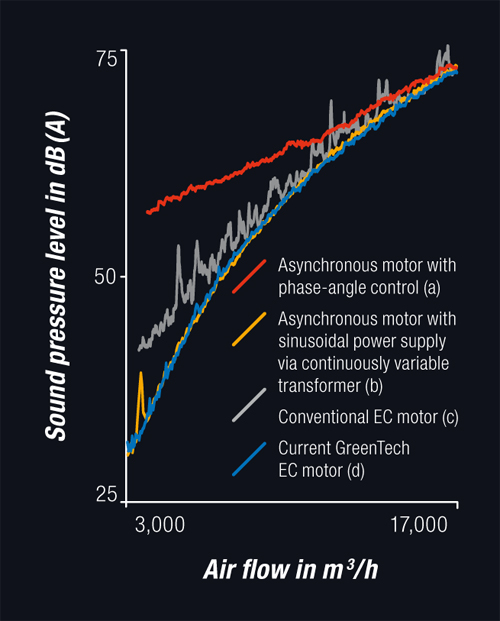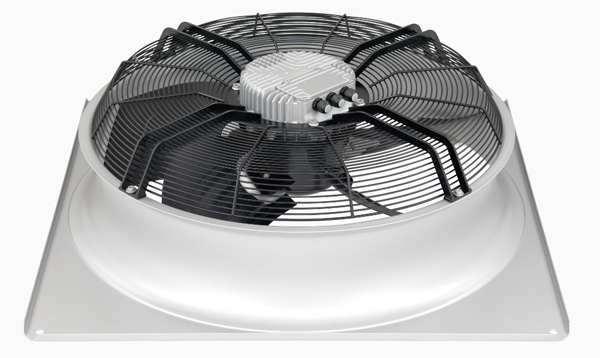Noise behaviour is a critical feature of fan drives. Fans are used in a wide variety of different devices and installations that have individual structure-borne vibration characteristics. The usual procedure for avoiding resonance by matching the natural oscillation and excitation is often not effective for these variablespeed drives. Secondary measures such as mechanical decoupling are device-specific and incur extra costs. Therefore, this application calls for a solution with robust noise reduction and low vibration excitation, which provides good results in various specific applications.
Three-phase asynchronous motors work with a sinusoidal power supply with low vibration and noise. Problems can occur in speed setting due to current harmonics caused by the speed controller. Continuous and low-noise speed setting performance requires operation while connected to a well-adjusted frequency inverter. In this case, the EC motor is the preferable solution from an economic perspective. Though the motor’s vibratory behaviour is not always optimal due to the design principle, ebm-papst considers this an opportunity to develop particularly low-noise EC drives.
For EC motors, we distinguish the causes of noise and vibration excitation between alternating forces caused by permanent magnets and those caused by electromagnetic effects. For example, the slots of the stator cause a variable magnetic air gap permeance which, in conjunction with the permanent magnet field excitation, generates torque fluctuations known as cogging torque. The commutation of the currents in the windings can also cause electromagnetically induced fluctuation. In addition to the torque fluctuation, the forces acting on the rotor in a radial direction are also of great importance.The motor and commutation electronics likewise have an effect on the noise behaviour. ebm-papst develops and produces both drive components as one unit — an important requirement for an optimal drive system. Thanks to a beneficial combination of the number of slots and poles and a special sheet steel and magnet geometry, the cogging torque of the ebm-papst motors is less than 0.5 percent of the rated torque. Conventional motors have cogging torque between 5 and 8 percent. In addition, a method of current commutation is used that is specially optimised for fans. This provides an ideal compromise between low vibration and high efficiency.
Optimising the motor and commutation electronics together makes it possible to improve the vibration and noise behaviour of our EC motors dramatically. Today’s drives provide excellent results, even in sensitive applications. Normally, no additional specific measures are required, decreasing the application effort substantially.
 The noise comparison shows a three-phase asynchronous motor with speed that has been changed via phase-angle control (a) and using a continuously variable transformer with the ideal sinusoidal power supply (b). For comparison, the curve of a conventional EC motor (c) is shown. The current GreenTech EC motors (d) attain values comparable to the three-phase asynchronous motor in its most favourable operating case.
The noise comparison shows a three-phase asynchronous motor with speed that has been changed via phase-angle control (a) and using a continuously variable transformer with the ideal sinusoidal power supply (b). For comparison, the curve of a conventional EC motor (c) is shown. The current GreenTech EC motors (d) attain values comparable to the three-phase asynchronous motor in its most favourable operating case.


Leave a comment